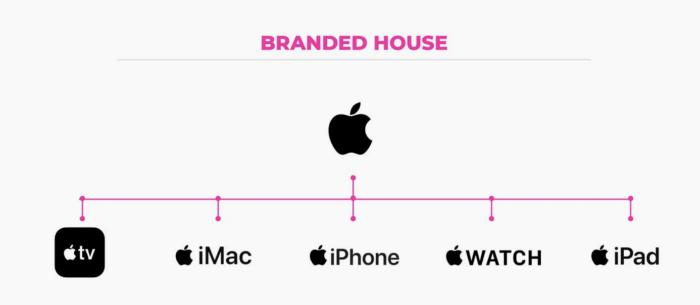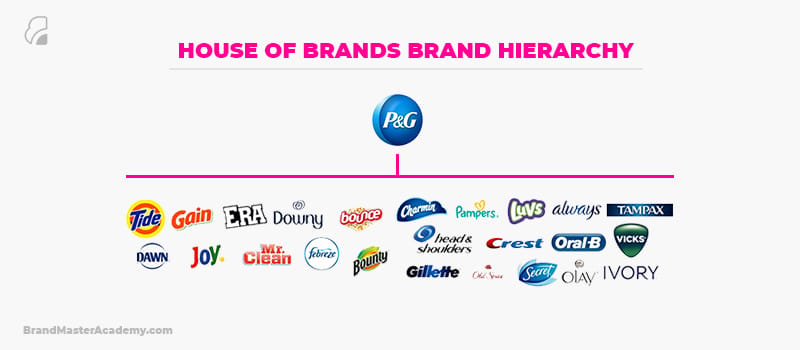- Marketing MindBites
- Posts
- Brand Architecture 101
Brand Architecture 101
Structuring your portfolio without chaos

In today's dynamic and overwhelming marketplace, effective brand architecture stands as a foundational pillar for sustainable business success. It is the strategic framework that organizes a company's entire portfolio of brands, products, and services, acting as a navigational instrument for both the organization and its customers. As leading marketing thinkers often underscore, the ultimate goal is to cultivate clarity, efficiently maximize brand strength, and profoundly simplify the decision-making journey for the customer.
The Pillars of Purpose: Goals and Objectives of Sound Brand Architecture
A robust brand architecture serves several critical objectives. Fundamentally, it seeks to illuminate brand relationships, enabling consumers to effortlessly grasp what a company offers and how its various products or services interconnect. This intrinsic clarity dramatically reduces the cognitive effort required from consumers, facilitating quicker, more intuitive purchasing decisions—a process often referred to as System 1 thinking. Experts in strategic brand management highlight that a well-designed architecture optimizes brand equity by judiciously determining when to harness the power of a "mother brand"—a dominant corporate or master brand—and when it is strategically prudent to cultivate a distinct sub-line or an entirely new, independent brand. This pivotal choice is paramount for the efficient allocation of marketing resources and for amplifying market impact.
Leveraging a potent parent brand offers substantial advantages. Research consistently shows that a highly regarded corporate brand can imbue new offerings with its positive associations, inherent trust, and perceived quality. This "umbrella brand" strategy can significantly accelerate market acceptance for new products and services, simultaneously reducing marketing expenditures by capitalizing on existing brand recognition. However, this approach is not without its risks; any negative perception or incident associated with a sub-brand could potentially cast a shadow over the entire parent brand portfolio. Thus, senior leaders must meticulously assess the interconnectedness of market segments and the potential for adverse spillovers when contemplating to place a new venture under an established brand umbrella.
Conversely, the development of a novel sub-line or a wholly separate brand becomes strategically compelling when the new offering is designed to appeal to a distinct market segment, embodies a fundamentally different value proposition, or carries a higher risk profile that could threaten the parent brand's integrity. This approach provides unparalleled flexibility in crafting unique positioning and messaging, allowing for precise targeting of niche audiences' specific needs and desires without compromising the core identity and established equity of the primary brand.
Branded House vs. House of Brands: A Critical Strategic Choice
The two quintessential models defining brand architecture are the "Branded House" and the "House of Brands," each characterized by distinct advantages, inherent tradeoffs, and specific strategic applications. The choice between these paradigms profoundly dictates a company's market approach, organizational structure, and ultimately, its competitive trajectory.
Branded House: Unified Strength
In a Branded House architecture, the corporate brand reigns supreme, acting as the primary identifier, with all subsidiary brands, products, and services explicitly linked to it. This model is akin to a family where all members proudly share a prominent surname, deriving status and recognition from their familiarities. Consider technology giants like Google, whose vast array of services—from Google Search and Google Maps to Google Drive and Google Cloud—all unequivocally carry the ubiquitous "Google" identifier. Similarly, FedEx operates as a Branded House, with FedEx Express, FedEx Ground, and FedEx Freight all reinforcing the overarching corporate brand.
Pros of a Branded House:
Synergy and efficiency: Marketing investments in the master brand naturally accrue benefits across all sub-brands, leading to significant cost efficiencies and amplified communication reach.
Brand equity transfer: The established reputation and trust cultivated by the corporate brand seamlessly extend to all its offerings, providing an immediate and potent credibility boost to new product launches. As some studies on corporate brand equity reveal, migrating towards a branded house model can streamline efforts and optimize overall brand performance.
Simplified consumer navigation: A clear, consistent brand identity pervading the entire portfolio makes it considerably easier for consumers to comprehend the full spectrum of offerings and make confident purchasing decisions.
Robust corporate identity: This structure powerfully reinforces the parent company's overarching mission, vision, and values across every customer touchpoint, fostering a cohesive organizational narrative.
Cons of a Branded House:
Risk of cross-contamination: A solitary misstep or negative event associated with one product or service within the portfolio has the potential to tarnish the reputation of the entire brand family.
Limited flexibility: This model can impose constraints on a company's ability to target highly diverse market segments with truly differentiated messaging, as all brands must align with and uphold the core corporate identity.
Brand stretching challenges: Extending the brand into vastly disparate product categories can strain the master brand's relevance and potentially dilute its original meaning and perceived expertise.
House of Brands: Diverse Appeal
In stark contrast, a House of Brands architecture comprises a portfolio of independent, stand-alone brands, each meticulously crafted with its own distinct identity, unique marketing strategy, and specific target audience. In this model, the corporate entity typically operates in the background, often remaining largely unknown or irrelevant to the end consumer. Procter & Gamble exemplifies this strategy with its extensive collection of household names such as Tide, Pampers, Gillette, and Crest, each thriving as a separate entity catering to specific consumer needs and preferences. Unilever, with brands like Dove and Axe, also demonstrates a strong House of Brands approach, allowing each brand to project its unique personality and appeal to diverse demographic & psychographic targets.
Pros of a House of Brands:
Precision-targeted market penetration: Each brand can be precisely sculpted and positioned for a specific market segment, enabling highly differentiated value propositions and clean, compelling messaging.
Effective risk mitigation: The failure or negative publicity impacting one brand is significantly less likely to propagate and damage other brands within the portfolio, effectively shielding the corporate entity and its broader assets.
Agility and flexibility: This architecture empowers companies to venture into diverse product categories and experiment with varied market approaches without diluting or compromising a singular master brand.
Fosters internal competition: This model can stimulate healthy internal competition among brands, often driving innovation and enhancing market responsiveness.
Cons of a House of Brands:
Elevated marketing costs: Each individual brand needs separate and particular marketing, advertising, and brand-building investments, which can result in a substantially higher overall expenditure.
Reduced synergy: Opportunities for cross-promotion and shared marketing efficiencies between brands are limited, potentially sacrificing economies of scale.
Complex management: Overseeing a large and diverse portfolio of distinct brands demands considerable organizational resources, specialized expertise, and sophisticated strategic oversight.
Diminished corporate recognition: The inherent strength and overarching values of the parent company may not be readily apparent or communicated to consumers, making it more challenging to build and leverage corporate brand equity.
It is important to acknowledge that the choice between a Branded House and a House of Brands is seldom absolute. Many organizations adopt a hybrid approach, strategically positioning certain brands more closely to the motherbrand or corporate identity while granting others greater independence. The optimal strategy is often a convergence of several factors, including specific industry dynamics, the degree of product differentiation, the relatedness of customer bases, and the overarching strategic vision of the firm.
The System 1 Advantage: Simplifying Choices for Enhanced Performance
A profoundly effective brand architecture distinguishes itself by its capacity to simplify the complex landscape of consumer choices. In behavioral economics, System 1 thinking describes the fast, intuitive, and emotionally driven decision-making processes that predominantly operate beneath conscious awareness. A meticulously designed, easy-to-navigate, and inherently simple brand architecture directly influences market performance by facilitating these rapid, almost automatic decisions. It prevents consumers from becoming overwhelmed, a state that often leads to choice paralysis or disengagement.
When presented with a clear and coherent brand portfolio, consumers are not compelled to expend significant cognitive effort—characteristic of slower, more deliberate System 2 thinking—to decipher what they are evaluating or what a brand genuinely represents. Research in consumer psychology vividly illustrates that an elevated cognitive load can profoundly impact decision outcomes. When cognitive resources are scarce, individuals are more inclined to make impulsive, less reasoned choices, or may simply opt to defer a decision altogether. A poorly structured brand architecture generates cognitive friction, forcing consumers into the more demanding System 2 processing, which is both slower and more mentally demanding. This friction frequently ends up in consumer frustration or the abandonment of the purchasing journey.
For example, studies have shown that in highly stimulating retail environments, consumers often gravitate towards established national brands, partly because their cognitive capacity is reduced. This highlights a preference for easily recognizable and trusted options that require minimal mental processing. Likewise, a transparent brand structure cultivates a perception of simplicity, fostering an invaluable sense of trust and confidence in purchasing decisions. Companies that adeptly streamline their brand architecture often realize tangible benefits, including heightened customer satisfaction, augmented brand loyalty, and ultimately, substantial increases in sales volume. By engineering a frictionless customer journey, a meticulously architected brand portfolio empowers consumers to instinctively align with products that precisely meet their needs, thereby contributing directly to superior business outcomes.
A truly effective brand architecture transcends theoretical models, manifesting in real-world organizations that empower customers through clarity and seamless navigation. Let’s explore three contemporary examples that demonstrate how strategic brand architecture enhances the customer journey.
1. Apple: The Ecosystem of Simplicity
Apple stands as a prime example of a highly successful "Branded House" that masterfully leverages its iconic corporate brand to unify a diverse array of products and services. What Apple does best is create a cohesive and intuitive ecosystem where hardware, software, and services are seamlessly integrated, all reinforcing the singular Apple brand. This vertical integration, allows the company to deliver unparalleled user experiences and robust ecosystem compatibility across its Macintosh computers, iPhones, iPads, Apple Watches, and an ever-expanding catalogue of digital content and services like the App Store and Apple Music.
Apple's particular architecture helps customers navigate its portfolio by fostering a powerful sense of familiarity and trust. When a user purchases an iPhone, they expect that an Apple Watch will connect effortlessly, that iCloud will synchronize their data, and that new services will inherently adhere to the same high standards of design and functionality they've come to expect. This predictability and consistency minimize cognitive effort for the consumer, allowing for rapid adoption of new products and services without needing to learn entirely new interfaces. For example, if a customer knows how to use one Apple device, they can generally figure out another, leading to increased loyalty and a higher likelihood of staying within the Apple universe. This unified experience cultivates a strong sense of brand loyalty and a dedicated customer base, driving sustained growth and market dominance.

2. Procter & Gamble: The Household Name Multiplier
Procter & Gamble is arguably one of the most iconic examples of a "House of Brands," managing an immense portfolio of consumer goods that dominate various market segments. What P&G does best is create and nurture distinct brands, each with its own identity, target audience, and marketing strategy, often with little to no visible association with the parent company. From Tide laundry detergent and Pampers diapers to Gillette razors and Crest toothpaste, P&G brands are household names across the globe.
P&G's particular architecture helps customers navigate its vast portfolio by allowing each brand to speak directly to specific needs and desires without confusing consumers with a singular corporate identity. For example, a parent choosing diapers likely focuses on Pampers' benefits, while an individual buying shaving cream considers Gillette. The sheer independence of these brands allows P&G to capture a wide array of market segments across diverse categories, and to diverse consumer preferences without diluting any single brand's message or value proposition. This strategy minimizes the risk of negative associations spreading across the portfolio; if one brand faces a challenge, the others remain largely unaffected. Consumers interact with trusted, specialized products, making choices based on the individual brand's promise rather than the overarching corporate entity, thereby simplifying decision-making in often crowded retail environments.

Conclusion
The strategic deployment of brand architecture is far more than a mere organizational exercise; it is a profound business imperative that dictates how an enterprise engages with its market and how consumers dissect its value. By meticulously defining the relationships and hierarchies within a portfolio of brands, companies can construct powerful, coherent ecosystems that not only propel business performance but also profoundly simplify the customer experience. This structured approach allows for intuitive decision-making, transforming potential shelf chaos into clarity, and fostering lasting loyalty in an increasingly complex world.
Thank you for reading! If you want more great marketing content, make sure you check One Liner, delivering great lessons every day.
